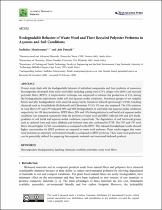 ResearchSpace
ResearchSpace
Biodegradable behaviour of waste wool and their recycled polyster preforms in aqueous and soil conditions
JavaScript is disabled for your browser. Some features of this site may not work without it.
- ResearchSpace
- →
- Research Publications/Outputs
- →
- Journal Articles
- →
- View Item
| dc.contributor.author |
Muniyasamy, Sudhakar

|
|
| dc.contributor.author |
Patnaik, Asis

|
|
| dc.date.accessioned | 2021-06-23T08:39:28Z | |
| dc.date.available | 2021-06-23T08:39:28Z | |
| dc.date.issued | 2021-01 | |
| dc.identifier.citation | Muniyasamy, S. & Patnaik, A. 2021. Biodegradable behaviour of waste wool and their recycled polyster preforms in aqueous and soil conditions. <i>Journal of Renewable Materials, 9(10).</i> http://hdl.handle.net/10204/12024 | en_ZA |
| dc.identifier.issn | 2164-6325 | |
| dc.identifier.issn | 2164-6341 | |
| dc.identifier.uri | DOI: 10.32604/jrm.2021.014904 | |
| dc.identifier.uri | http://hdl.handle.net/10204/12024 | |
| dc.description.abstract | Present study deals with the biodegradable behavior of individual components and their preforms of nonwoven biocomposites developed from waste wool fibers including coring wool (CW), dorper wool (DW) and recycled polyester fibers (RPET). A respirometric technique was employed to estimate the production of CO2 during the biodegradation experiments under soil and aqueous media conditions. Functional groups of test samples before and after biodegradation were analyzed using Fourier transform infrared spectroscopy (FTIR). Leaching chemicals such as formaldehyde (hydrolyzed) and Chromium VI (Cr VI) was also measured. The CO2 emission in wool fibers CW and DW indicated 90% and 60% biodegradation in soil burial and aqueous media conditions respectively, for 100 days incubation. RPET fibers, 20% and 10% biodegradation in soil burial and aqueous media conditions was measured respectively while the preforms of waste wool and RPET reflected 30% and 25% biodegradation in soil burial and aqueous media conditions, respectively. The degradation of end functional groups such as carbonyl (keto and ester), aldehyde and hydroxyl were also confirmed by FTIR. The DW and CW wool fibers showed higher Cr(VI) concentration as compared to the RPET. The released formaldehyde results showed higher concentration for RPET preforms as compared to waste wool preforms. These results suggest that waste wool preforms are extremely environment friendly as compared to RPET preforms. Thus, waste wool preforms it can be potentially utilized for preparing biocomposite materials and associated biobased products. | en_US |
| dc.format | Fulltext | en_US |
| dc.language.iso | en | en_US |
| dc.relation.uri | https://www.techscience.com/jrm/v9n10/42553 | en_US |
| dc.source | Journal of Renewable Materials, 9(10) | en_US |
| dc.subject | Biocomposites | en_US |
| dc.subject | Biodegradation | en_US |
| dc.subject | Leaching chemicals | en_US |
| dc.subject | Synthetic polyesters | en_US |
| dc.subject | Waste wool fibers | en_US |
| dc.title | Biodegradable behaviour of waste wool and their recycled polyster preforms in aqueous and soil conditions | en_US |
| dc.type | Article | en_US |
| dc.description.pages | 1661-1671 | en_US |
| dc.description.note | This work is licensed under a Creative Commons Attribution 4.0 International License, which permits unrestricted use, distribution, and reproduction in any medium, provided the original work is properly cited. | en_US |
| dc.description.cluster | Chemicals | en_US |
| dc.description.impactarea | en_US | |
| dc.identifier.apacitation | Muniyasamy, S., & Patnaik, A. (2021). Biodegradable behaviour of waste wool and their recycled polyster preforms in aqueous and soil conditions. <i>Journal of Renewable Materials, 9(10)</i>, http://hdl.handle.net/10204/12024 | en_ZA |
| dc.identifier.chicagocitation | Muniyasamy, Sudhakar, and Asis Patnaik "Biodegradable behaviour of waste wool and their recycled polyster preforms in aqueous and soil conditions." <i>Journal of Renewable Materials, 9(10)</i> (2021) http://hdl.handle.net/10204/12024 | en_ZA |
| dc.identifier.vancouvercitation | Muniyasamy S, Patnaik A. Biodegradable behaviour of waste wool and their recycled polyster preforms in aqueous and soil conditions. Journal of Renewable Materials, 9(10). 2021; http://hdl.handle.net/10204/12024. | en_ZA |
| dc.identifier.ris | TY - Article AU - Muniyasamy, Sudhakar AU - Patnaik, Asis AB - Present study deals with the biodegradable behavior of individual components and their preforms of nonwoven biocomposites developed from waste wool fibers including coring wool (CW), dorper wool (DW) and recycled polyester fibers (RPET). A respirometric technique was employed to estimate the production of CO2 during the biodegradation experiments under soil and aqueous media conditions. Functional groups of test samples before and after biodegradation were analyzed using Fourier transform infrared spectroscopy (FTIR). Leaching chemicals such as formaldehyde (hydrolyzed) and Chromium VI (Cr VI) was also measured. The CO2 emission in wool fibers CW and DW indicated 90% and 60% biodegradation in soil burial and aqueous media conditions respectively, for 100 days incubation. RPET fibers, 20% and 10% biodegradation in soil burial and aqueous media conditions was measured respectively while the preforms of waste wool and RPET reflected 30% and 25% biodegradation in soil burial and aqueous media conditions, respectively. The degradation of end functional groups such as carbonyl (keto and ester), aldehyde and hydroxyl were also confirmed by FTIR. The DW and CW wool fibers showed higher Cr(VI) concentration as compared to the RPET. The released formaldehyde results showed higher concentration for RPET preforms as compared to waste wool preforms. These results suggest that waste wool preforms are extremely environment friendly as compared to RPET preforms. Thus, waste wool preforms it can be potentially utilized for preparing biocomposite materials and associated biobased products. DA - 2021-01 DB - ResearchSpace DP - CSIR J1 - Journal of Renewable Materials, 9(10) KW - Biocomposites KW - Biodegradation KW - Leaching chemicals KW - Synthetic polyesters KW - Waste wool fibers LK - https://researchspace.csir.co.za PY - 2021 SM - 2164-6325 SM - 2164-6341 T1 - Biodegradable behaviour of waste wool and their recycled polyster preforms in aqueous and soil conditions TI - Biodegradable behaviour of waste wool and their recycled polyster preforms in aqueous and soil conditions UR - http://hdl.handle.net/10204/12024 ER - | en_ZA |
| dc.identifier.worklist | 24644 | en_US |





